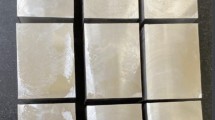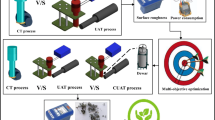Abstract
This study examines AISI630 steel to gain insight into the chip morphology. Chip morphology provides useful information about the plastic shear deformation involved in the machining process. The presented study aims to integrate the innovative artificial intelligence driven method to efficiently analyse the saw-tooth chip geometry. The paper used an artificial intelligence inspired algorithm based on the image processing of segmented chips that quantifies various output responses, including peak, valley, pitch, chip segmentation ratio, chip compression ratio, and shear angle. In order to generate chips related data, a finite element-based machining model was prepared for the stainless steel AISI630 workpiece. The performance of data collected using artificial intelligence (AI) inspired technique has been re-evaluated using manual image processing tool Image J software. The peaks and valleys of the chip’s morphology are used to calculate the chip segmentation ratio. The study showed valleys can introduce average percentage errors of 7.3%. The shear angle is computed using the chip compression ratio, with an average percentage error of 2.4%. In addition, pitch values obtained from chip morphology have a percentage error of 5.2%.








Similar content being viewed by others
References
Bermingham, M.J., Palanisamy, S., Kent, D., Dargusch, M.S.: A comparison of cryogenic and high pressure emulsion cooling technologies on tool life and chip morphology in Ti-6Al-4V cutting. J. Mater. Process. Technol. 212(4), 752–765 (2012). https://doi.org/10.1016/j.jmatprotec.2011.10.027
Yildirim, Ã.V., Kivak, T., Sarikaya, M., Şirin, Å.: Evaluation of tool wear, surface roughness/topography and chip morphology when machining of Ni-based alloy 625 under MQL, cryogenic cooling and CryoMQL. J. Mater. Res. Technol. 9(2), 2079–2092 (2020). https://doi.org/10.1016/j.jmrt.2019.12.069
Saad Elmunafi, M.H., Noordin, M.Y., Elshwain, A.E., Kurniawan, D.: Influence of cutting condition on chip morphology when turning hardened stainless steel using coated carbide cutting tools under minimum quantity of lubrication. AIP Conf. Proc. vol. 2262, (2020). https://doi.org/10.1063/5.0015828
Mohan, R., Harshavardhana, N., Chaudhari, M., Jeyanthi, S., Abimannan, G.: “Analysis on surface finish and chip morphology during dry turning process,” in Materials Today: Proceedings, vol. 46, pp. 999–1002, doi: (2021). https://doi.org/10.1016/j.matpr.2021.01.137
Sampaio, M.A., Machado, Ã.R., Laurindo, C.A.H., Torres, R.D., Amorim, F.L.: Influence of minimum quantity of lubrication (MQL) when turning hardened SAE 1045 steel: A comparison with dry machining. Int. J. Adv. Manuf. Technol. 98, 1–4 (2018). https://doi.org/10.1007/s00170-018-2342-x
Cagan, S.C., Venkatesh, B., Buldum, B.B.: “Investigation of surface roughness and chip morphology of aluminum alloy in dry and minimum quantity lubrication machining,” Mater. Today Proc, vol. 27, no. xxxx, pp. 1122–1126, doi: (2020). https://doi.org/10.1016/j.matpr.2020.01.547
Behera, B.C., Alemayehu, H., Ghosh, S., Rao, P.V.: A comparative study of recent lubri-coolant strategies for turning of Ni-based superalloy. J. Manuf. Process. 30, 541–552 (2017). https://doi.org/10.1016/j.jmapro.2017.10.027
Sivaiah, P., Chakradhar, D.: Effect of cryogenic coolant on turning performance characteristics during machining of 17 – 4 PH stainless steel: A comparison with MQL, wet, dry machining. CIRP J. Manuf. Sci. Technol. 21, 86–96 (2018). https://doi.org/10.1016/j.cirpj.2018.02.004
**uli, F., Wenxing, L., Yongzhi, P., Wentao, L.: Morphology evolution and micro-mechanism of chip formation during high-speed machining. Int. J. Adv. Manuf. Technol. 98, 1–4 (2018). https://doi.org/10.1007/s00170-017-0411-1
Li, G., Cai, Y., Qi, H.: Prediction of the critical cutting conditions of serrated chip in high speed machining based on linear stability analysis. Int. J. Adv. Manuf. Technol. 94, 1–4 (2018). https://doi.org/10.1007/s00170-017-0958-x
Li, G., Smith, J., Liu, W.K.: Finite element simulation of saw-tooth chip in high-speed machining based on multiresolution continuum theory. Int. J. Adv. Manuf. Technol. 101, 5–8 (2019). https://doi.org/10.1007/s00170-018-3078-3
Chandra Behera, B., Sudarsan Ghosh, C., Paruchuri, V.R.: Study of saw-tooth chip in machining of Inconel 718 by metallographic technique. Mach. Sci. Technol. 23(3), 431–454 (2019). https://doi.org/10.1080/10910344.2019.1575397
Chen, X., Tang, J., Ding, H., Liu, A.: A new geometric model of serrated chip formation in high-speed machining. J. Manuf. Process. vol 62(no February 2020), 632–645 (2021). https://doi.org/10.1016/j.jmapro.2020.12.053
Xu, Z., Zheng, G., Cheng, X., Xu, R., Zhao, G., Tian, Y.: Fractal characteristics of chip morphology and Tool. Mater. (Basel). no. 13(4), 1020 (2020)
Singh, B.K., Roy, H., Mondal, B., Roy, S.S., Mandal, N.: Measurement of chip morphology and multi criteria optimization of turning parameters for machining of AISI 4340 steel using Y-ZTA cutting insert. Measurement. no. 142, 181–194 (2019). https://doi.org/10.1016/j.measurement.2019.04.064
Devotta, A.M., Sivaprasad, P.V., Beno, T., Eynian, M.: Predicting continuous chip to segmented chip transition in orthogonal cutting of C45E steel through damage modeling. Metal (Basel) 10(4), 789 (2020). https://doi.org/10.3390/met10040519
Devotta, A., Beno, T., Löf, R., Espes, E.: Quantitative characterization of chip morphology using computed tomography in orthogonal turning process. Procedia CIRP. no. 33, 299–304 (2015). https://doi.org/10.1016/j.procir.2015.06.053
Pimenov, D.Y., Bustillo, A., Wojciechowski, S., Sharma, V.S., Gupta, M.K., Kuntoğlu, M.: Artificial intelligence systems for tool condition monitoring in machining: Analysis and critical review. J. Intell. Manuf. no. (2022). https://doi.org/10.1007/s10845-022-01923-2
Abbas, A.T., Pimenov, D.Y., Erdakov, I.N., Taha, M.A., Rayesel, M.M., Soliman, M.S.: Artificial intelligence monitoring of hardening methods and cutting conditions and their effects on surface roughness, performance, and finish turning costs of solid-state recycled aluminum alloy 6061 chips. Metal (Basel) 8(6), 214 (2018). https://doi.org/10.3390/met8060394
Ngerntong, S., Butdee, S.: “Surface roughness prediction with chip morphology using fuzzy logic on milling machine,” Mater. Today Proc, vol. 26, no. xxxx, pp. 2357–2362, doi: (2019). https://doi.org/10.1016/j.matpr.2020.02.506
Hrechuk, A., Bushlya, V., M’Saoubi, R., Ståhl, J.E.: Quantitative analysis of chip segmentation in machining using an automated image processing method. Procedia CIRP. no. 82, 314–319 (2019). https://doi.org/10.1016/j.procir.2019.03.272
ThirdWaveSystems: Third Wave AdvantEdgeTM User’s Manual Version 7.3. (2017)
Man, X., Ren, D., Usui, S., Johnson, C., Marusich, T.D.: Validation of finite element cutting force prediction for end milling. Procedia CIRP. no. 1(1), 663–668 (2012). https://doi.org/10.1016/j.procir.2012.04.119
Maranhão, C., Davim, J.P.: Finite element modelling of machining of AISI 316 steel : Numerical simulation and experimental validation. Simul. Model. Pract. Theory. no. 18(2), 139–156 (2010). https://doi.org/10.1016/j.simpat.2009.10.001
Acknowledgements
Authors would like to thank the support offered by Third Wave System by providing complementary research license for the AdvantEdge software.
Author information
Authors and Affiliations
Corresponding author
Additional information
Publisher’s Note
Springer Nature remains neutral with regard to jurisdictional claims in published maps and institutional affiliations.
Rights and permissions
Springer Nature or its licensor (e.g. a society or other partner) holds exclusive rights to this article under a publishing agreement with the author(s) or other rightsholder(s); author self-archiving of the accepted manuscript version of this article is solely governed by the terms of such publishing agreement and applicable law.
About this article
Cite this article
Ali, S., Alshibi, A., Nasreldin, A. et al. Artifical intelligence inspired approach to numerically investigate chip morphology in machining AISI630. Int J Interact Des Manuf (2023). https://doi.org/10.1007/s12008-023-01340-6
Received:
Accepted:
Published:
DOI: https://doi.org/10.1007/s12008-023-01340-6




